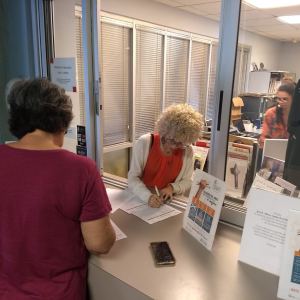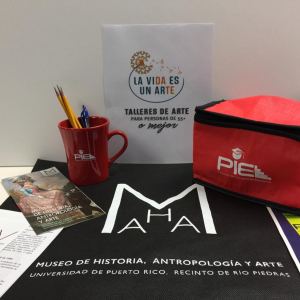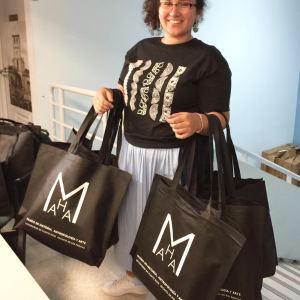
In 2018, 20 organizations enrolled in a special museum cohort of Aroha Philanthropies’ Seeding Vitality Arts program. With funding from Aroha, and training provided by Lifetime Arts, these museums are developing high quality, intensive arts learning opportunities for older adults. In the coming year we will feature guest posts from many of these museums, sharing what they’ve learned. Today’s post is from Lisa Ortega-Pol, museum educator at Museo de Historia, Antropología y Arte of the University of Puerto Rico.
When the UPR Museum won a grant from Aroha Philanthropies to lead an art-making program directed at older adults, it blew my mind. We are located in Puerto Rico, which at the time was still recovering from the devastating aftermath of two hurricanes, so the news that we were selected for the Seeding Vitality Arts in Museums project brought joy on several levels.
The UPR Museum embraced the opportunity to strengthen its role in our community by becoming a venue for people to find and express themselves. When we learned about the concept of creative aging and all of its implications at our staff development for the program in Minneapolis, we were inspired by the potential to achieve that goal. We came back to our museum with a new sense of mission and worldview, and ready to share our excitement with the community.
An unexpected joy
Through the decades, the Museum of History, Anthropology and Art of the University of Puerto Rico (known to locals as simply “the UPR Museum”) has responded to the times, with its programming shifting focus from one demographic to another (collectors and donors, our campus community, schools, and families).
Skip over related stories to continue reading articleIn recent years, we had been noticing increased participation from people 55 and older in our ongoing art workshop program, Family Sunday. We collected feedback forms from these participants on workshop topics they were most interested in, and included the results in our proposal for Seeding Vitality Arts in Museums. Ultimately, we decided our program would be a series of creative writing workshops.
After analyzing the available facilities, going over logistics, and sorting out the ideal teaching artists, we established a final calendar: the first cycle would run from July through August 2019, the second cycle October through November 2019, and the third cycle February through March 2020. That would leave a few weeks in between cycles to prepare reports and press releases, create digital albums, and work out the details of the next.
The announcement of our museum receiving the grant award to develop programming for people “age 55 or better” came out in the press earlier in the year, causing an avalanche of phone and email inquiries that took us by surprise. However, the official launching of the promos for the creative writing workshops started in early June, with a soft launch first through social media, then our mailing lists, followed by a full blast in the press and on university radio. The response was slow at first, but then people suddenly started calling, emailing, and coming in person to enroll. We sold out two weeks before our first cycle started!

Enrollment for our second cycle opened and was filled in a matter of days, and the same happened when enrollment for our third cycle opened. We were amazed by all the interest! As the program took off, we were also invited to two radio interviews, two phone interviews for the press, and a four-minute spot on a local TV show.
We were also surprised to see the excitement of our broader university community. Two units from our campus offered goodies to include in the tote bags for each participant. The Legal Support Center sent brochures with valuable information about their free services and the Continuing Education Program for Adults contributed with coffee mugs and a lunch bag. The former we reached out to, but the latter reached out to us first! Inside each tote bag there was ruled paper, pens, pencils, a coffee mug, a lunch bag, and brochures. Claudia León helped to prepare the bags as part of her Summer internship through the Young Ambassador Program, an initiative from the Smithsonian Latino Center.


People of “accumulated youth” speak out
Even after we announced that the workshops were fully booked, we kept receiving calls, emails, and personal visits from older adults in the community. One email message: “There’s a lot of talent and a yearning to stay active for those of us who are ‘55 or better.’ I love that motto. Thank you for all you do for this sector that has a lot of knowledge and experience. I see it also as a sublime way to pay us back for all we have contributed to this country. I hope I can be part of future initiatives.”
From a phone call: “You’re booked? Well, I’ll be! What other activities will you have for people like me, you know, of accumulated youth?”
In person: “I know you’re all booked, and that’s a pity…for me at least. Are you sure that I cannot stand quietly in a corner so I can listen to the workshop instructor? Look, I have self-published about six books and I’m not sure where I stand in the creative writing universe! There’s so much I can benefit from this!”
Preparations
How did we manage this high demand? First, we kept everybody—from front desk staff to the director—informed on the progress of the program, through emails and “hallway” meetings. Second, all staff got involved one way or another in the preparations. This was of utmost importance, since we naively thought that the program could be run from and by the Education Office staff alone. Everyone from our security officer, to front of house staff, to administrative assistants had a role to play as word got out and more phone calls and visitors came asking about the program. With that group effort, we were able to manage the enrollment process, the questions, the “add me to your waiting list” petitions, etc.
Our newly hired marketing specialist created a timeline of when and how we would release information about the program, and together with the graphic artist proposed a logo and branding to help create awareness of the new initiative. The administrative assistant came up with the enrollment forms and a system to keep up with each cycle, payments, waiting lists, etc.
While this was happening, my education colleague Oneida Matos-Adorno and I were working out logistics, making decisions, finalizing class content and administrative details with the teaching artists, searching for art supply quotations, submitting curriculum proposals on the online platform, appearing in interviews, etc.
Conclusion
Learning and spreading the news about creative aging has been both a nobler responsibility and a bigger challenge than I imagined. We at the Museo de Historia, Antropología y Arte have become advocates of the population age 55 and better (whether current or future members) and have provoked, through our involvement in the Seeding Vitality Arts in Museums initiative, a renewed institutional commitment to creating programming for this sector of society.
We feel honored to have been selected by Aroha Philanthropies and empowered to do our part after receiving support from Lifetime Arts plus good intel from AAM’s Center for the Future of Museums. The overwhelming response we received when we announced our program only confirmed the truths we learned in Minneapolis about a growing population with clear intellectual, health, and social needs. We are grateful to be able to provide accessible and meaningful programming attuned to the times and circumstances of the community we serve.
About the author:
Lisa Ortega-Pol has twenty years of experience in the museum education field. Her interests include the art and science of communicating cultural heritage and object-based learning. She studied Humanities and Visual Arts at the University of Puerto Rico, completed a master’s degree in Fine Art from Memphis College of Art (Tennessee, U.S.A.), and is certified in Teaching and Learning from the University of Cambridge (UK).









Comments